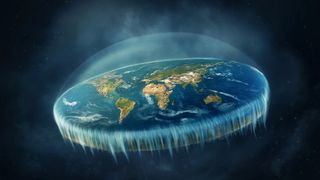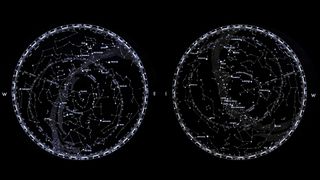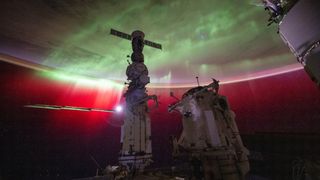How to debate a flat-Earther
Why do people believe this, and is it even worth getting into a debate over?

Paul M. Sutter is an astrophysicist at SUNY Stony Brook and the Flatiron Institute, host of Ask a Spaceman and Space Radio, and author of How to Die in Space.
A number of ancient cultures believed that the Earth was flat because, simply, they didn’t know any better. But incredibly, there are people today who still believe that the Earth is flat, despite centuries of evidence proving the contrary.
So, why do people believe this, and is it even worth getting into a debate over?
Surprisingly, while there are mountains of proof, the discussion around the idea of a "flat Earth" has nothing to do with evidence at all.
Related: How big is Earth?
You can see Earth is round
To put it bluntly, we know more about the curvature of Earth than almost any other topic in the realm of physical science. There are so many experiments, observations and demonstrations that have, time and time again, revealed the curve of the Earth.
And it all starts with the horizon.
As objects recede from you, they begin to look smaller and slowly disappear in a very unique way: first their bottoms become hidden, and then their tops. If you've ever watched a ship on the horizon, you've seen this for yourself. Similarly, from a great distance, the tops of tall objects like mountains are visible well before their bases.
And Earth's curvature is clearly apparent from high altitudes, as Capt. Albert Stevens of the U.S. Army Air Corps showed in the 1930s. In December 1930, for example, Stevens snapped a photo looking westward while flying at an altitude of 21,000 feet (6,400 meters) above Villa Mercedes, Argentina.
"The Andes Mountains, 287 miles [462 kilometers] away, and although taller than the plane's altitude, lay below the sensible horizon, marked by the white horizontal line in the photograph," NASA officials wrote in a description of the flight. "The Earth's curvature explains this phenomenon, as described in the diagram accompanying the photograph. The Earth's curvature is also visible laterally in the photograph, although the effect is subtle as the image encompasses only 1/360 of the Earth's circumference."
And in November 1935, Stevens and Capt. Orvil Anderson took a photo from a balloon that lifted off from Rapid City, South Dakota and soared to a maximum altitude of 72,395 feet (22,066 m).
"The photograph showed the troposphere-stratosphere boundary and the actual curvature of the Earth and demonstrated the potential for long-range reconnaissance from high-altitude balloons," NASA officials wrote.
Earth's atmosphere is capable of playing funny tricks on our eyes, with different layers of air bending light into interesting directions. This phenomenon, a side effect of Earth's curvature, isn't a sure-fire guarantee of our planet's curve, but it’s a start.
But even if you can't look to the horizon for evidence, you can look up.
Different stars are visible from different parts of Earth, in two very peculiar ways. First, there is the division between the northern and southern hemispheres. So, you can see Polaris, the star nearly directly above Earth's north geographic pole, quite easily in northern latitudes.

But as you travel south, approaching the equator, Polaris sinks lower and lower toward the horizon. Once you’ve crossed that boundary, you can't see it at all — it's blocked by the curve of Earth in that direction.
Similarly, as you travel south, new constellations await your delighted gaze — ones that would be completely obscured by Earth's curve if you stayed up north.
There's another trick you can play, too. If you live in an especially flat area, you'll be able to see stars down to the horizon but no farther (because Earth is in your way). But if you travel up — say, to the top of a mountain — you get a better vantage point and can see stars farther down than you could before.
In fact, the ninth-century Abbasid Caliph al-Ma-mun sent an expedition to do exactly that and used those observations to measure Earth's circumference.
Related: Earth's atmosphere: Composition, climate & weather
Circles everywhere
You might not be able to mount such a scientific investigation to your nearest mountain peak. But there is something you can do to witness the curvature of Earth in the comfort of your own backyard. You just have to be lucky.
During a lunar eclipse, Earth passes between the sun and the moon, allowing Earth to cast its shadow on the moon. That shadow is always, always, always a circle, no matter where you are on the planet, no matter the timing of the eclipse. Always.
The only way to always cast a circular shadow is if the thing casting the shadow — in this case, Earth — is a globe. It's a matter of geometry.
And that's not to mention the countless photos of Earth taken by orbiting satellites and eyewitness testimonies from astronauts hailing from dozens of different countries, space programs and private organizations.

Our curved Earth also aligns perfectly with all of physics. Additionally, all of the other planets ever discovered also appear round, because that's how gravity likes things.
If you use gravity to, say, trust your GPS to give you accurate positions and calculate trajectories, then that same force will form material the size of Earth into a ball.
Related: What is the temperature on Earth?
Reasons behind the belief
I don't think this discussion is really about the actual evidence or the scientific process, however.
People who believe that Earth is flat aren't coming to that conclusion from the same types of observations. Instead, they believe that we are being misled and lied to, that scientists (including me) want you to believe that Earth is round, despite its flatness.
So the question isn't "Why do people believe in a flat Earth?" but rather "Why do people believe in a conspiracy?" And the answer is the same reason it always is: a lack of trust.
Many people don’t trust the society around them, most notably the representatives of that society. That trust often falls even further when it comes to elite representatives of that society, which include government officials, members of academia and scientists like me.
By claiming that Earth is flat, people are really expressing a deep distrust of scientists and science itself.
So if you find yourself talking to a flat-Earther, skip the evidence and arguments and ask yourself how you can build trust.
Additional resources
You can learn more about the first photographs that clearly showed Earth's curvature in this NASA story. This explainer from Arizona State University lays out clearly and concisely the plentiful evidence for our planet's spherical shape. (Nearly spherical, rather: Earth's rotation causes it to be slightly squashed at the poles and swollen at the equator, a shape known as an oblate spheroid.) And this piece by fivethirtyeight.com explains why people believe in conspiracy theories such as the flat-Earth idea.
Bibliography
- Bergreen, L. "Over the Edge of the World: Magellan's Terrifying Circumnavigation of the Globe." William Morrow, 2003. https://www.amazon.com/Over-Edge-World-Terrifying-Circumnavigation/dp/006093638X
- Nataraj, N. "Earth and Space: Photographs from the Archives of NASA." Chronicle Books, 2015. https://www.amazon.com/Earth-Space-Photographs-Archives-NASA/dp/1452134359
- Novella, S. "The Skeptics' Guide to the Universe: How to Know What's Really Real in a World Increasingly Full of Fake." Grand Central Publishing, 2018. https://www.amazon.com/gp/product/1538760533/
Join our Space Forums to keep talking space on the latest missions, night sky and more! And if you have a news tip, correction or comment, let us know at: community@space.com.
Get the Space.com Newsletter
Breaking space news, the latest updates on rocket launches, skywatching events and more!

Paul M. Sutter is an astrophysicist at SUNY Stony Brook and the Flatiron Institute in New York City. Paul received his PhD in Physics from the University of Illinois at Urbana-Champaign in 2011, and spent three years at the Paris Institute of Astrophysics, followed by a research fellowship in Trieste, Italy, His research focuses on many diverse topics, from the emptiest regions of the universe to the earliest moments of the Big Bang to the hunt for the first stars. As an "Agent to the Stars," Paul has passionately engaged the public in science outreach for several years. He is the host of the popular "Ask a Spaceman!" podcast, author of "Your Place in the Universe" and "How to Die in Space" and he frequently appears on TV — including on The Weather Channel, for which he serves as Official Space Specialist.
-
rod My observation. This space.com report discusses briefly *evidence* based observations supporting the spherical Earth. However, what about reports like this using QM? https://forums.space.com/threads/new-quantum-paradox-throws-the-foundations-of-observed-reality-into-question.33556/#post-524588Reply
It would seem that *objective reality* cannot be determined then, thus flat earth folks can have a seat at the place of science too :)---Rod -
LijeBaley Probably the best way to debate a flat-Earther would be to send one up to the ISS and let them tell you what they see with their own eyes.Reply -
rod LijeBaley, consider the space.com report on QM universe I cited in post #2 where apparently there is no objective reality. Your proposed evidence for the flat earther to see, assumes that there exist in nature an objective reality that can be clearly defined. Yet space.com report undermines such a concept in science. Applying QM universe rules to the ISS and view from the ISS, that suggest the ISS may not be real and what is seen below may not be real too. A flat earther could simply cite this now and ask that the flat earth be taught in sciences classes now in public schools as an example. Also the Sun could be moving above the flat disk earth too, a form of geocentric astronomy that can be valid because there is no objective reality now in science, apparently.Reply -
LijeBaley Oh please, enough with the quantum voodoo. I read the same article and it’s just another possible theory put forth by theoretical physicists, no different than the theory that the universe is a digital simulation. Creative thinking at best. I’ll stick with the “I think therefore I am” version of reality that says the Earth is a sphere.Reply -
rod LijeBaley, I point out the *quantum voodoo* as a philosophy of interpreting nature, seems to appear more and more in QM reports. If I apply this approach to the macro universe, the cat is dead or alive also leads to the earth is flat and round too. Your version of reality is yours, flat earth folks will have another version of reality and no one can define a standard of verification that works for all to accept it seems. In my opinion, the scientific method breaks down and replaced with a different definition of reality, based upon different views and needs. I see this as the direction that science is taking today - my opinion. I do not agree with this but it looks like that to me---RodReply -
Helio QM describes the sub-micro world. Extrapolating by factors of billions doesn't work, else GR would look a lot different, and so would we.Reply
The Flat Earth belief seems to me another case of solipsism. Perhaps it's that our tendency to believe what we want to believe and, in this case believing in excess, that appearances are deemed satisfactory, whereby objective evidence becomes dismissed.
Apparently, those that hold the flat earth view aren't all conspiracy advocates. That's a little surprising. -
rod Helio, in your post #7, I know some flat earth folks. Conspiracy can play a role but for many, flat earth is empirical too. I have studied flat earth videos on measuring the distance to the Moon using telescopes, angles obtained, and plane trigonometry vs. spherical trigonometry. FE folks are correct like the Flat Earth Society. The Moon will always be much closer to the flat disk earth using plane trigonometry. At most the Moon is about 3400 miles away and about 0.5 degrees angular size, so much smaller in size too.Reply
However, I stand by what I said about QM philosophy interpretation of nature. Applying to the macro universe leads to no objective reality and the space.com report does suggest this to me. -
COLGeek Never let science, or facts, get in the way of a good argument. :rolleyes:Reply
Some folks' opinions will never be swayed, regardless of the facts before them. Many in the FE camp are of this ilk. -
Helio Reply
I don't know the trig approach they use, nor care to spend time on it, but the parallax would be 75x greater for a 3400 mile distance than actual. Two telescopes relatively close together could see this. Only one falsification is needed to debunk their model, but hundreds exist. Finding one element to be correct and hundreds false is not a scientific model, even if one element is found.rod said:Helio, in your post #7, I know some flat earth folks. Conspiracy can play a role but for many, flat earth is empirical too. I have studied flat earth videos on measuring the distance to the Moon using telescopes, angles obtained, and plane trigonometry vs. spherical trigonometry. FE folks are correct like the Flat Earth Society. The Moon will always be much closer to the flat disk earth using plane trigonometry. At most the Moon is about 3400 miles away and about 0.5 degrees angular size, so much smaller in size too.
It won't shock me if most flat earthers are nice folks. But when worldviews allow the scrutiny of science due to an overlap with it, then it is subject to the test of science.
However, I stand by what I said about QM philosophy interpretation of nature. Applying to the macro universe leads to no objective reality and the space.com report does suggest this to me.
If you remove the teeth from a dog then it won't bite. Redefining objectivity changes things. Objectivity is simply repeating tests by many others and agreeing on the results. And it helps to remember that not agreeing on results for clearly understood reasons, is what scientists look forward to, unlike many philosophies and religions. -
Russ Kincade Reply
I like the idea of letting them build their own rockets instead like Mike Hughes did:LijeBaley said:Probably the best way to debate a flat-Earther would be to send one up to the ISS and let them tell you what they see with their own eyes.
https://www.bbc.com/news/world-us-canada-51602655
The people who are incapable of critical thinking (like anti-vaxers and supporters of lying politicians) and believe what they want to believe are a danger to society.